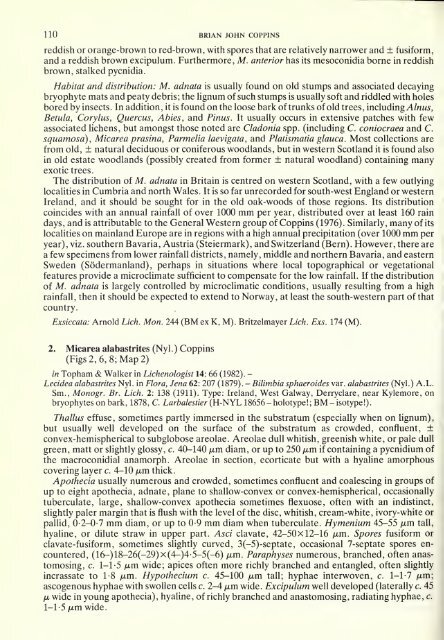Bulletin of the British Museum (Natural History)
Bulletin of the British Museum (Natural History)
Bulletin of the British Museum (Natural History)
Create successful ePaper yourself
Turn your PDF publications into a flip-book with our unique Google optimized e-Paper software.
110 BRIAN JOHN COPPINS<br />
reddish or orange-brown to red-brown, with spores that are relatively narrower and ± fusiform,<br />
and a reddish brown excipulum. Fur<strong>the</strong>rmore, M. anterior has its mesoconidia borne in reddish<br />
brown, stalked pycnidia.<br />
Habitat and distribution: M. adnata is usually found on old stumps and associated decaying<br />
bryophyte mats and peaty debris; <strong>the</strong> Ugnum <strong>of</strong> such stumps is usually s<strong>of</strong>t and riddled with holes<br />
bored by insects. In addition, it is found on <strong>the</strong> loose bark <strong>of</strong> trunks <strong>of</strong> old trees, including ^/nwj^,<br />
Betula, Corylus, Quercus, Abies, and Pinus. It usually occurs in extensive patches with few<br />
associated lichens, but amongst those noted are Cladonia spp. (including C. coniocraea and C.<br />
squamosa), Micarea prasina, Parmelia laevigata, and Platismatia glauca. Most collections are<br />
from old, ± natural deciduous or coniferous woodlands, but in western Scotland it is found also<br />
in old estate woodlands (possibly created from former ± natural woodland) containing many<br />
exotic trees.<br />
The distribution <strong>of</strong> M. adnata in Britain is centred on western Scotland, with a few outlying<br />
localities in Cumbria and north Wales. It is so far unrecorded for south-west England or western<br />
Ireland, and it should be sought for in <strong>the</strong> old oak-woods <strong>of</strong> those regions. Its distribution<br />
coincides with an annual rainfall <strong>of</strong> over 1000 mm per year, distributed over at least 160 rain<br />
days, and is attributable to <strong>the</strong> General Western group <strong>of</strong> Coppins (1976). Similarly, many <strong>of</strong> its<br />
localities on mainland Europe are in regions with a high annual precipitation (over 1000 mm per<br />
year), viz. sou<strong>the</strong>rn Bavaria, Austria (Steiermark), and Switzerland (Bern). However, <strong>the</strong>re are<br />
a few specimens from lower rainfall districts, namely, middle and nor<strong>the</strong>rn Bavaria, and eastern<br />
Sweden (Sodermanland), perhaps in situations where local topographical or vegetational<br />
features provide a microclimate sufficient to compensate for <strong>the</strong> low rainfall. If <strong>the</strong> distribution<br />
<strong>of</strong> M. adnata is largely controlled by microclimatic conditions, usually resulting from a high<br />
rainfall, <strong>the</strong>n it should be expected to extend to Norway, at least <strong>the</strong> south-western part <strong>of</strong> that<br />
country.<br />
Exsiccata: Arnold Lich. Mon. 244 (BM ex K, M). Britzelmayer Lich. Exs. 174 (M).<br />
2. Micarea alabastrites (Nyl.) Coppins<br />
(Figs 2, 6, 8; Map 2)<br />
in Topham & Walker in Lichenologist 14: 66 (1982). -<br />
Lecidea alabastrites Nyl. in Flora, Jena 62: 207 (1879). - Bilimbia sphaeroides var. alabastrites (Nyl.) A.L.<br />
Sm., Monogr. Br. Lich. 2: 138 (1911). Type: Ireland, West Galway, Derryclare, near Kylemore, on<br />
bryophytes on bark, 1878, C. Larbalestier (H-NYL 18656-hoIotype!; BM-isotype!).<br />
Thallus effuse, sometimes partly immersed in <strong>the</strong> substratum (especially when on lignum),<br />
but usually well developed on <strong>the</strong> surface <strong>of</strong> <strong>the</strong> substratum as crowded, confluent, ±<br />
convex-hemispherical to subglobose areolae. Areolae dull whitish, greenish white, or pale dull<br />
green, matt or slightly glossy, c. 40-140 /x,m diam, or up to 250 ^im if containing a pycnidium <strong>of</strong><br />
<strong>the</strong> macroconidial anamorph. Areolae in section, ecorticate but with a hyaline amorphous<br />
covering layer c. 4-10 jxm thick.<br />
Apo<strong>the</strong>cia usually numerous and crowded, sometimes confluent and coalescing in groups <strong>of</strong><br />
up to eight apo<strong>the</strong>cia, adnate, plane to shallow-convex or convex-hemispherical, occasionally<br />
tuberculate, large, shallow-convex apo<strong>the</strong>cia sometimes flexuose, <strong>of</strong>ten with an indistinct,<br />
slightly paler margin that is flush with <strong>the</strong> level <strong>of</strong> <strong>the</strong> disc, whitish, cream-white, ivory-white or<br />
pallid, 0-2-0-7 mm diam, or up to 0-9 mm diam when tuberculate. Hymenium 45-55 yam tall,<br />
hyaline, or dilute straw in upper part. Asci clavate, 42-50x12-16 /xm. Spores fusiform or<br />
clavate-fusiform, sometimes slightly curved, 3(-5)-septate, occasional 7-septate spores encountered,<br />
(16-)18-26(-29)x(4-)4-5-5(-6) jxm. Paraphyses numerous, branched, <strong>of</strong>ten anastomosing,<br />
c. 1-1-5 /xm wide; apices <strong>of</strong>ten more richly branched and entangled, <strong>of</strong>ten slightly<br />
incrassate to T8 /xm. Hypo<strong>the</strong>cium c. 45-100 /am tafl; hyphae interwoven, c. 1-T7 /xm;<br />
ascogenous hyphae with swollen cells c. 2-4 /xm wide. Excipulum well developed (laterally c. 45<br />
/x wide in young apo<strong>the</strong>cia), hyaline, <strong>of</strong> richly branched and anastomosing, radiating hyphae, c.<br />
1-T5 /xm wide.

















